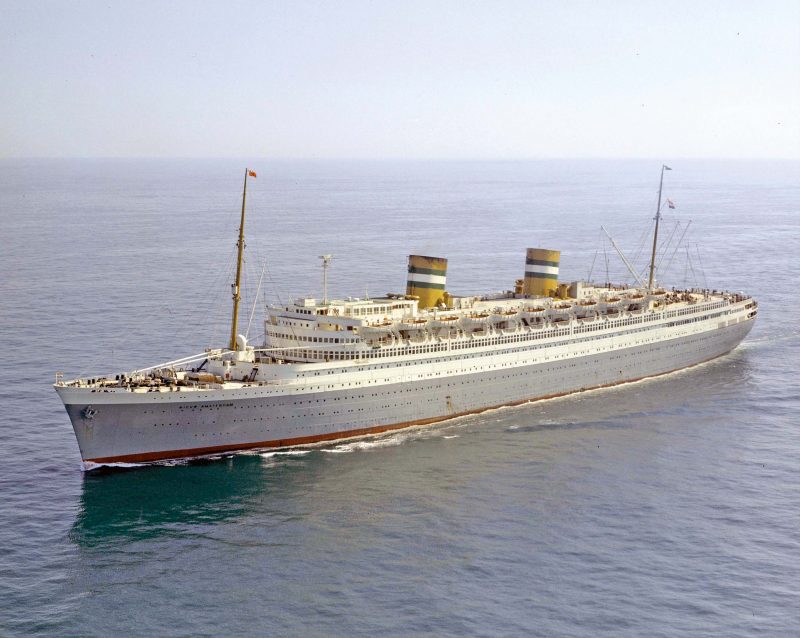
Rotterdam is the largest seaport in Europe, and stands on the Nieuwe Maas river, part of the Rhine-Maas-Scheldt delta and is linked to Europort deep draught outport by the New Waterway. It serves the hinterland of the Rhine valley and central Europe as far as Basle in Switzerland. It is a great city and port to visit for all shiplovers, with the 185 metre high Euromast on Parkaade beside the river and the extensive Rotterdam Maritime Museum two of my favourites. A very fast lift takes one to the top of the Euromast to give extensive views of the port and the surrounding city, and the Maritime Museum has ship models, books for sale inside, and numerous floating exhibits outside ranging from former Dutch ocean going salvage tugs to harbour craft such as grain elevators. The nomenclature for all of the early Rotterdam docks ended in ‘haven’ e.g. Veerhaven, and this system was used by one of the early Rotterdam shipping companies of Van Uden for all of their ships when founded in 1848. Willem Ruys was born in 1809 as the fourth of seven sons of a Dutch clergyman and he began in business at the age of nineteen years in 1828 as Van Ulphen and Ruys in 1828. The first steamship left Rotterdam for the East Indies in 1851 with Willem Ruys as her cargo agent, and he took his second son, also called Willem, into partnership ten years later as Willem Ruys & Zonen, managers of the great Rotterdam liner fleet of Royal Rotterdam Lloyd.
The greatest of the deep sea Rotterdam liner fleets was, of course, Holland America Line, the Nederlandsch Americaanische Stoomboot Maatschappij (N.A.S.M.) founded in April, 1873 by Dr. Anton Plate, Otto Reuchlin, and Willem van der Hoeven, and with Prince Hendrik of the Netherlands as its royal patron. This article also examines the great deep sea fleets of Royal Rotterdam Lloyd, and the extensive passenger and cargo-liner fleets of Van Nievelt, Goudriaan & Company (Rotterdam South America Line) with services to South America and to Chicago on the Great Lakes.
Holland America Line (N.A.S.M.)
This large fleet of over 180 vessels used a nomenclature for passenger liners of names ending in ‘dam’ e.g. Noordam, and for cargo-liners names ending in ‘dijk’ or ‘dyk’ e.g. Dinteldyk. The famous name of Rotterdam was used five times including for the first ship that made her maiden voyage across the Atlantic on 15th October 1872. She was owned by Plate, Reuchlin & Company, founded earlier that year by Dr. Anton Plate, Otto Reuchlin, and Marten Mees. Emigrant passengers and cargo were hard to find during that first winter with the company almost forced into liquidation, and consequently Nederlandsch Americaanische Stoomboot Maatschappij (N.A.S.M.) was founded on 9th April 1873 with a capital of two million guilders with investment by new shareholders to take over Rotterdam and her sister Maas. Unlike French Line, Norddeutscher Lloyd and Hamburg Amerika Line, the new company had no Government subsidies or mail contracts and relied solely on emigrant traffic. The new company was managed by three Managing Directors, a practice that was maintained for the next hundred years.
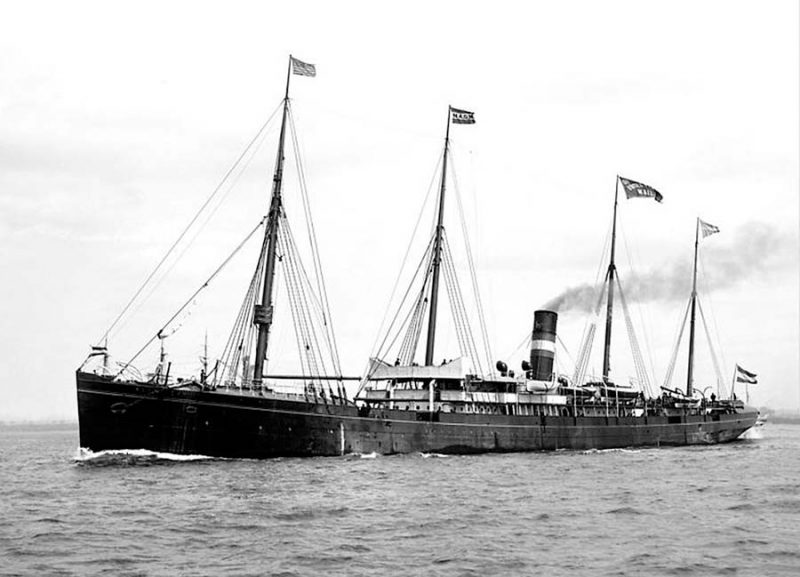
Head Office of the new company was on Wilhelminakade and improvements were being made at this time to the New Waterway, which joined the port to the North Sea, and much deepening was needed before larger vessels could transit. The port of Amsterdam was used during 1892/93 by larger company vessels because of the very long deepening and construction time of the New Waterway. The title of Holland America Line began to be used officially in 1898 instead of N.A.S.M. since it was easier to pronounce in the United States, and the fleet at this time consisted of nine liners in Statendam of 10,491 grt, Rotterdam (3) of 8,186 grt, Amsterdam (2) of 3,629 grt, Maasdam (2) of 3,707 grt, Edam (3) of 3,329 grt, Obdam of 3,254 grt, Spaarndam of 4,368 grt, Veendam of 3,707 grt and Werkendam of 3,573 grt. Three more larger liners of 12,350 grt were also under construction or on order as Potsdam, Ryndam and Noordam.
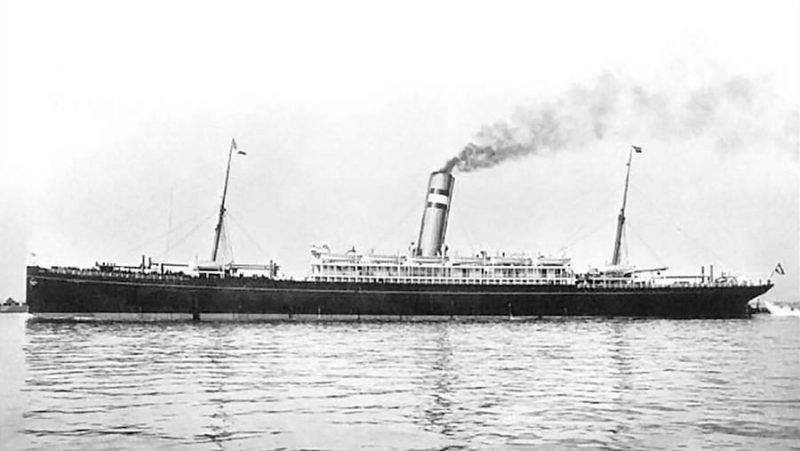
The first cargo-liners joined the fleet in 1901 from the Hartlepool yard of Furness, Withy & Co. Ltd. in Soestdijk, Amsteldijk and Sloterdijk of 9,095 dwt. The company entered into an arrangement with Furness, Withy & Co. Ltd. eight years later under which it took over the six cargo ships of the Neptune Line, which operated the Rotterdam to Baltimore service. Part of the deal was that Furness Shipping & Agency Ltd. of Rotterdam would remain agents for the service and Furness, Withy & Co. Ltd. would remain the agents on the American coast. Holland America Line then appointed Furness, Withy & Co. Ltd. as their agents at Baltimore, Newport News, Philadelphia and all Canadian east coast ports, later also becoming agents for the Pacific coast ports and on the Great Lakes. Three of the six cargo ships acquired were built on Tyneside of 10,100 dwt during 1907/09.
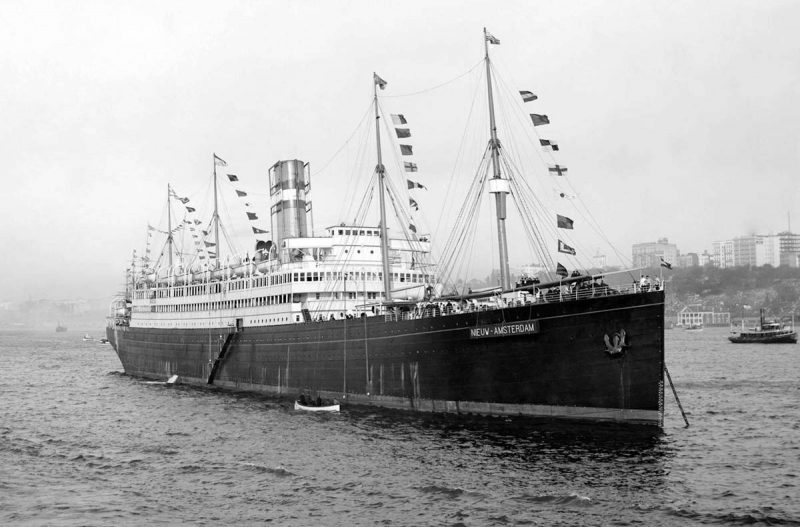
New passenger liners were constructed by Harland & Wolff Ltd. at Belfast during 1906/08 in Nieuw Amsterdam and Rotterdam (4), the latter ship at 24,149 grt remaining the biggest ship in the fleet until 1929. She had accommodation for 520 First Class passengers, 555 Second class passengers and 2,500 steerage passengers. Nieuw Amsterdam could accommodate 417 First Class passengers, 391 Second Class passengers and 2,300 in steerage. By 1915, a large fleet of 36 ships had been built up consisting of passenger liners, cargo-liners, passenger tenders and harbour craft such as tugs. This number had recently been augmented by nine purchased ships to take advantage of the gap that had arisen from German liners no longer operating their services to New York in wartime. Several ships were badly damaged by mine or torpedo during the war, with two lost, including the three funnelled liner Justicia of 32,234 grt, which was being managed for the British Government. She was torpedoed by UB64 on 19th July 1918 off Fanad Head in the North Channel off Northern Ireland while on a voyage from Belfast to New York, and it took another five torpedoes to sink her, all fired in broad daylight. The cargo-liner Zaandijk had been torpedoed and sunk on 22nd February 1917 by U21 off the Scilly Isles.
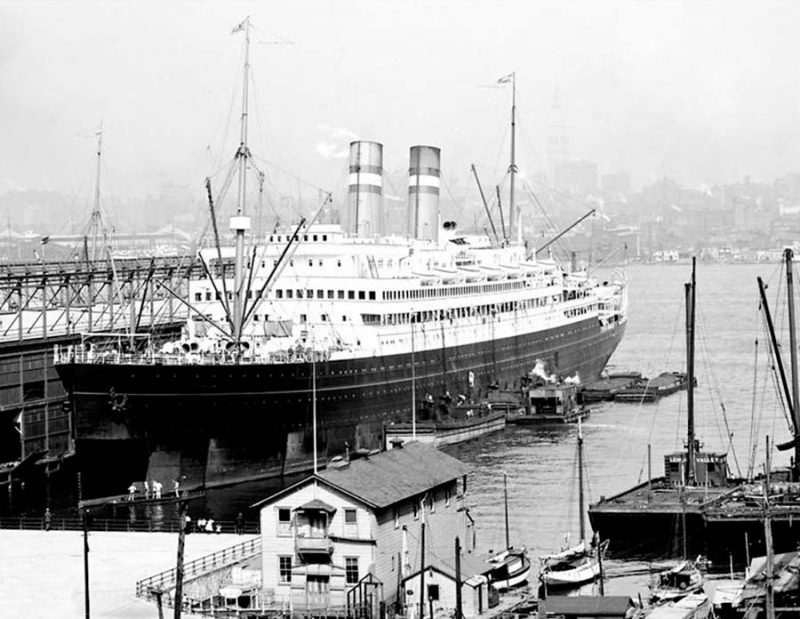
In 1921, the big Holland America Line fleet stood at thirty liners and cargo ships, with another 17 ships building, in addition to sixteen passenger tenders and harbour craft. The fleet served on a dozen different routes across the Atlantic to Canada, East Coast and West Coast of the United States, Mexico, Cuba and Caribbean ports, although the express passenger service remained between Rotterdam and New York. Other routes were from Rotterdam to the Middle East, India and Burma via the Suez Canal, and between New York and the Dutch East Indies. During the 1920s, the company increased its position on the North Atlantic as competitors such as the Red Star Line were declining. The express Rotterdam to New York service was now weekly with calls at Boulogne and Plymouth, the latter port replaced by Southampton westbound in 1923. Two large liners, Rotterdam (4) and Nieuw Amsterdam with extremely comfortable accommodation alternated their sailings with those of a smaller pair, Ryndam and Noordam completed in 1901/02. The cargo-liner fleet was updated with eight ‘B’ class ships of 9,800 dwt during 1921/22 in Burgerdijk, Blijdendijk, Binnendijk, Blommersdijk, Bilderdijk, Boschdijk, Breedijk and Beemsterdijk.
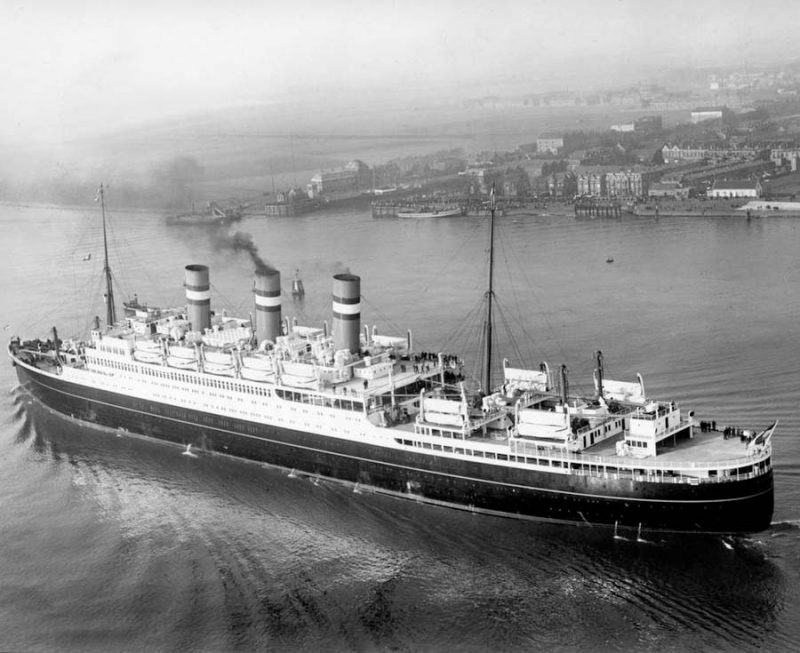
However, Holland America Line was very badly hit by the severe curtailment in U.S. immigration from a pre-war figure of many millions to only 360,000 people in 1921 and then was further slashed to only 160,000 people in 1924. A three funnelled liner of 29,500 grt had been ordered from the Belfast yard of Harland & Wolff Ltd. in 1921, but after her launch as Statendam (3) on 11th September 1924 she was laid up for over four years and eventually sailed on her maiden voyage on 11th April 1929 to New York to replace Ryndam. She had accommodation for 510 First class passengers and 1,144 passengers in Second and Third classes. Intermediate liners of the inter war years included the Volendam and Veendam of 15,434 grt completed in 1922/23, and the twin funnelled quartet of Spaarndam, Maasdam, Leerdam and Edam completed in 1922 for the service to Cuba and Mexico. This quartet had two earlier cargo-liner sisters in Gaasterdijk and Grootendijk, and their passenger accommodation was much altered during the inter war years with their Third Class accommodation abolished in 1934 to leave only 28 passengers in First Class. Their second dummy funnels were removed when transferred to the U.S. East coast service in 1934, and they had six holds served by 35 derricks to handle their 11,400 tonnes of cargo. Spaarndam and several other company vessels spent more than four years in lay up during the Depression.
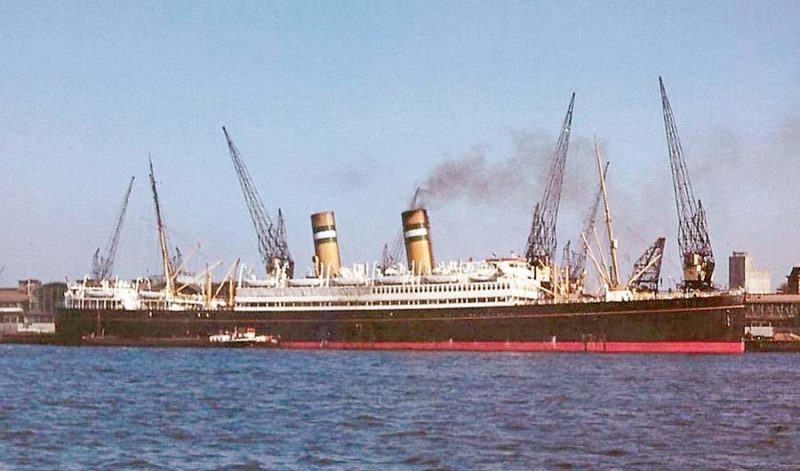
The attractive profile of the large twin funnelled liner Nieuw Amsterdam of 36,287 grt when completed in April 1938 by the Rotterdam Dry Dock yard made her the ‘star’ liner of the inter war period. She cost $12 million and had a good amount of sheer in her hull with her second funnel as a dummy, and after her maiden voyage to New York on 10th May 1938 she quickly earned a reputation as one of the loveliest liners ever built. She had accommodation for 556 Fist Class, 455 in Tourist Class and 309 in Third Class, and was twin screw with her Parsons turbines giving a service speed of 21 knots. The intermediate liners Noordam, Westerdam and Zaandam completed in 1938/39 of 10,800 grt were basically cargo ships with accommodation for 160 passengers in a superior Tourist Class. They operated the Rotterdam to New York and Philadelphia route until the Spring of 1940 when they were laid up. The fleet strength on 1st September 1939 was 28 ships of which four were set on fire and lost when the Germans entered Rotterdam on 10th May 1940. The three funnelled liner Statendam was deliberately set on fire and the flames were then bombed to make her a total loss along with Boschdijk, Dinteldijk, Drechdijk with Damsterdijk and Veendam badly damaged but recovered at the end of the war. The Wilhelminakade quay and terminal of the company was completely destroyed, and six others of the fleet became war losses.
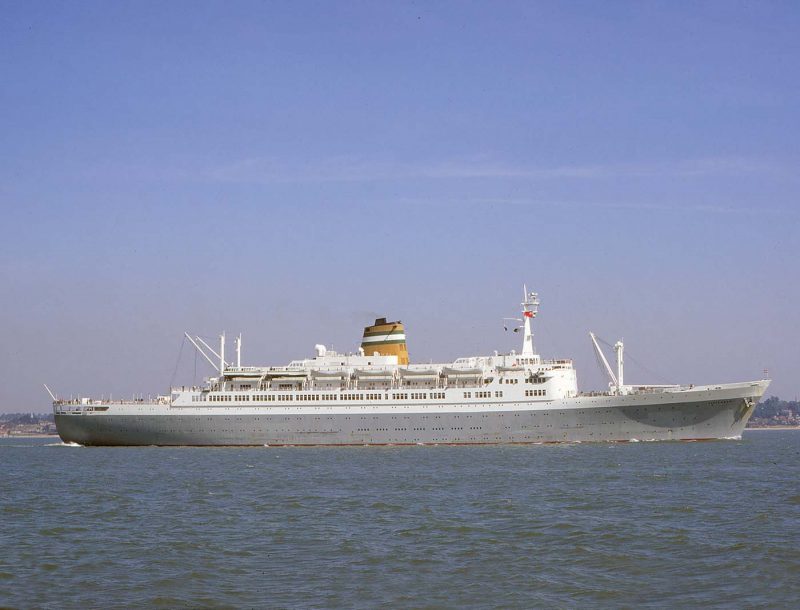
Rebuilding of the fleet took place after Westerdam re-opened the Rotterdam to New York passenger service on 28th June 1946. Purchased standard cargo ships included a dozen ‘Victory’ types with a good turn of speed of 16 knots and accommodation for 12 passengers, and four other standard ‘C3’ types which were all given ‘dyk’ names beginning with ‘A’, plus ‘Empire’, ‘Liberty’ and other types as replacements for lost ships. The new Soestdyk and Schiedyk of 12,260 dwt were completed by the Belfast yard of Harland & Wolff Ltd. and by 1949 fleet strength had regained its pre-war level of 28 ships. Four cargo-liner hulls of 500 feet in length were ordered from the Schiedam yard of Wilton Fijenoord, of which the first was completed in June 1950 as Diemerdyk of 11,780 dwt for the Pacific route. However, the second and third hulls were completed as the grey hulled passenger liners Ryndam and Maasdam with accommodation for 39 First Class passengers and 854 in Tourist Class. They were employed until 1960 on the Rotterdam to Southampton, Le Havre and New York route and then were switched to the Quebec and Montreal run during the summer seasons. The fourth hull was completed as the cargo-liner Dinteldyk in March 1957.
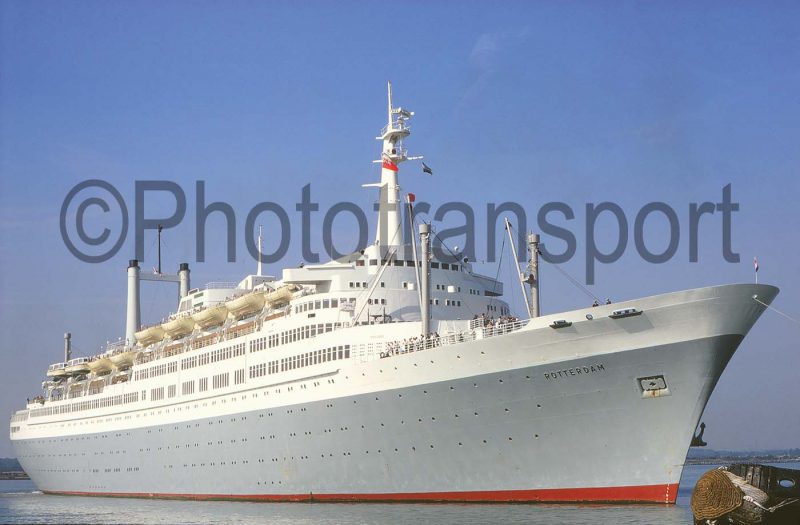
The great new liners Statendam (4) and Rotterdam (5) were completed in February 1957 and September 1959 as two class ships with accommodation for 951 and 1,456 passengers respectively. The cargo-liner fleet was similarly updated with six of the ‘K’ class during 1956/61. However, the advent of jet aeroplane travel on the Atlantic in 1959 meant that the three ship passenger fleet of Nieuw Amsterdam (2), Statendam (4) and Rotterdam (5) increasingly went cruising. In 1964, only fifty voyages were made to New York from Rotterdam and eleven to Montreal, falling to only 21 crossings in 1968 and only 13 crossings a year later. Finally, in 1971 after 98 years of Transatlantic passenger travel, Holland America Line ceased Atlantic crossings and concentrated on the cruising market. The classic Nieuw Amsterdam (2) made her last cruise in January 1974 from Port Everglades to Los Angeles and then sailed for Kaohsiung and oblivion.
The cargo fleet of the company during its centenary year of 1973 consisted of five cargo-liners, one ‘Lash’ barge ship Bilderdyk, and two container ships Atlantic Star and Atlantic Crown operating in the Transatlantic Atlantic Container Line (ACL) service formed by four companies in 1965. A new livery had been adopted by the fleet in 1972 consisting of red funnels with a central green/white/green houseflag, worn for the first time by Statendam (4) and the newly purchased Veendam and Volendam from Moore McCormick Line and modified for cruising. The company withdrew from the North Pacific cargo service in January 1974, and a year later the entire cargo fleet was sold to the Brostrom Group of Sweden for £40 million. The heavy lift fleet of Van der Laan Shipping & Trading had been purchased in 1971 but was also put up for sale in 1975, and the diversified businesses of ship chandlers, ship instruments, steel cable and tarpaulin manufacturers were also disposed of so that Holland America Line could concentrate on world wide cruising and particulary to Alaska from Vancouver where it was the world leader.
In September 1983, the Head Office was moved to Seattle to be nearer to its new cruising markets and a year later the fleet consisted of three cruise ships in Rotterdam (5), Nieuw Amsterdam (3) and Noordam (3). Windstar Cruises was acquired in June 1987 and in November 1988 the four ship cruising fleet and the goodwill of Holland America Line was purchased by Carnival Cruises Inc. of Miami for $625 million. Today, fifteen American owned cruise ships operate under the Holland America Line brand name.
Royal Rotterdam Lloyd (Willem Ruys & Zonen)
The Dutch East Indies islands of Java and Sumatra were the destination of this big fleet of over two hundred ships, with cargo also obtained from the other islands in the archipelago from cargo transshipped from the vessels of the Koninklijke Paketvaart Maats (KPM) after the latter was formed in 1888 jointly by Rotterdam Lloyd and Nederland Line. The main Dutch towns on Java were Batavia, the capital, followed by Surabaya, Bandung and Bogor, and the Rotterdam Lloyd fleet had as its nomenclature town and place names in the Dutch East Indies. On 1st January 1875, the Stoomboot Reederij ‘Rotterdamsche Lloyd’ was formed by Willem Ruys and J.G.N. Hoven, a coal merchant friend of the family. The first four steamers to sail under the new company name to Batavia were two British steamers, Hampton and Torrington, and two new Dutch steamers, Groningen and Friesland, with the round trip taking five months. The steamer Groningen was wrecked at Maasvlakte near the Hook of Holland after only three round voyages on 6th January 1876 and the newly completed sister Drenthe took her place. A fleet of eight sister passenger and cargo ships of 3,300 dwt formed the main fleet from 1877 onwards with accommodation for 26 First Class passengers, sixteen in Second Class plus many troops berthed in the holds.
In 1881, the company name was changed to Stoomvaart Maats Rotterdamsche Lloyd (Rotterdam Steam Navigation Company), and two years later the company was reformed as N.V. Rotterdamsche Lloyd. The steamer Merapi of 1889 was the first to have a grey hull which was used for all subsequent ships. After the delivery of Merapi, the fleet was divided into mail passenger liners, and cargo-liners, which normally carried only twelve passengers, above this number a doctor was required and if ladies were to be carried a stewardess was also necessary. A fleet of fourteen ships was being traded in 1893, and the first twin screw mail liner Sindoro of 5,471 grt was delivered in 1900 with accommodation for eighty First Class passengers, 38 in Second Class, and 400 troops forward in the holds. A sister Goentoer was completed two years later when fleet strength was then twenty ships.
A subsidiary tramp ship company was established in 1899 as Stoomvaart Maats Triton, and cargoes included sugar, rice, maize, cassava, rubber, tea, coffee, iron ore, nickel ore and manganese ore. The Java-China-Japan Line (JCJL) was formed in 1902 with other Dutch companies, Java-Bengalen Line in 1906, Java-Australia Line in 1908, and Java-Pacific Line in 1915. The fleet in October 1914 stood at nine modern mail steamers, the oldest being Sindoro of 1900 and 22 cargo ships with two more on order. The mail liners included Ophir of 1904, Wilis of 1905, Rindjani of 1906, Kawi of 1907, Tabanan of 1908, Tambora of 1909, and the Insulinde of 9,615 grt completed at Flushing in 1914 with accommodation for 308 passengers in four classes. She was the first of the larger mail steamers and during the Great War she carried her name in large letters on her hull with the neutral Dutch colours in bars either side but not in flag form. The Java-Pacific Line was a joint Rotterdam Lloyd, Nederland Line and JCJL service from Java, Hong Kong, Manila to San Francisco and proved successful as the German counterpart on the route since 1910 had been withdrawn due to the war. Four ships were lost during the war in Palembang, Kediri, Bandoeng and Jacatra, with Ophir burnt out on 8th November 1918 shortly after leaving Gibraltar, forcing a return to the Rock, where she settled on the bottom.
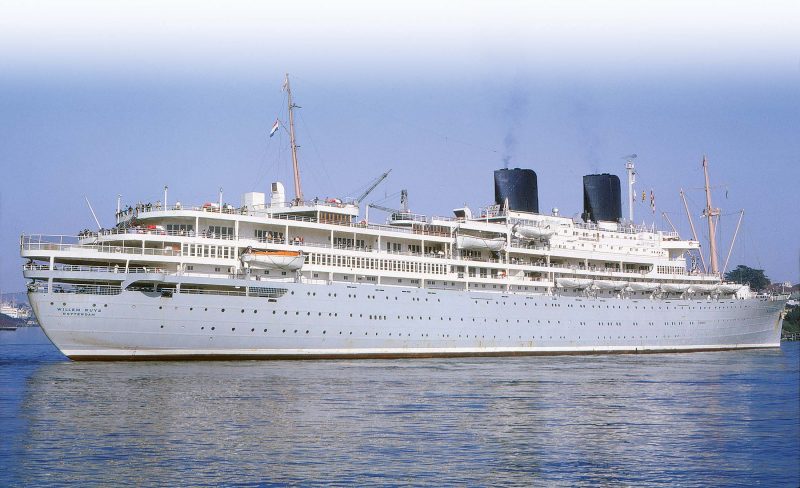
A similar new mail liner to Insulinde of 1914 was completed in 1919 as the twin funnelled Patria of 9,891 grt with accommodation for 334 passengers in four classes. She had been laid down at the end of 1914 at Flushing and after launching had been towed to Rotterdam to be away from the war danger zone on the coast. A big newbuilding programme was begun to give a fleet strength two years later of nine mail steamers, and 36 cargo ships with another eight building. In 1920, the United Netherlands Navigation Company (VNS) was formed by a consortium of Dutch shipowners to divide up the worldwide routes, and Rotterdam Lloyd was appointed manager of Holland-Australia Line with three ships allocated to the service in Almkerk, Arendskerk and Aagtekerk but painted in Rotterdam Lloyd colours.
The German mail liner Marie Woermann of 7,690 grt was awarded to the company in June, 1921 as war reparations and renamed Tjerimai, and the new twin funnelled liner Slamat of 11,406 grt was completed at Flushing in April 1923 with accommodation for 397 passengers in four classes. A sister was completed in 1926 as Indrapoera and was followed by another slightly larger sister in Sibajak of 1928. However, the finest of the company liners of the inter war period were the sisters Baloeran and Dempo of 16,980 grt and completed at Flushing during 1930/31. They had modern broad motorship funnels and were powered by twin ten cylinder Sulzer diesel engines to give service speeds of 18 knots. They had an unusual external feature of a ‘stepped in’ part of their superstructure on each side of the hull to give a degree of shade to the 262 First Class passengers accommodated on the top decks. The express mail service to the Dutch East Indies was maintained during the Depression by Baloeran and Dempo and two similar liners of the Nederland Line fleet, but many cargo ships were laid up for years or scrapped.

The company owned 32 ships in September 1939 with five mail liners and 27 cargo ships, however their finest mail liners Baloeran and Dempo were among the heavy casualties of 3 liners and 16 cargo ships lost in war casualties, together with 277 brave Dutch seafarers and staff. The decimated fleet was rebuilt with a new, larger mail liner in Willem Ruys, and four ‘C3’, three ‘Victory’, one ‘Ocean’ standard cargo ships and one fast ‘Empire’ cargo-liner as well as German ships as war reparations. Willem Ruys was launched at Flushing on 1st July 1946 by Mrs. E.E. Ruys-Van Houten, her director husband having been shot by the Germans as a reprisal for his delaying of her construction during wartime. On the occasion of her completion on 21st November 1947, Queen Wilhelmina of The Netherlands granted the honour of ‘Royal’ to the company name. Willem Ruys had accommodation for 869 passengers in 4 classes, and was twin funnelled with unusual boat stowage and the total absence of deck cranes, relying on shore cranes for the loading and unloading of her cargo.


The Dutch Government recognized the new State of Indonesia on 27th December 1949. However, the inter island traders of the KPM in particular could not be dispensed with by Indonesia, and although Indonesian State shipping was developed, Royal Rotterdam Lloyd and Nederland Line continued to trade to Indonesia for another decade. Finally, on 13th April 1960, Indonesia promulgated an order banning all Dutch passenger and cargo ships from trading to or from Indonesia. The former German cargo-liner Kertosono completed at Hamburg in 1936 made the last RRL sailing from Tandjong Priok (Djakarta) to Rotterdam on 6th August 1960. The new cargo-liners of Ampenan, Bengalen and the four ship ‘Wono’ class of 10,700 dwt and the eleven ship ‘River’ or ‘Lloyd’ class of 11,600 dwt formed a big fleet of 40 ships in 1960. All were now switched to new trades in the Pacific, and on routes to New York and Europe from Hong Kong, China, Japan, Korea and Taiwan. Diversification also included 5 tankers on long term charter to Shell and bulk carriers on long term ‘contracts of affreightment’, in a joint effort with Nederland Line to fight their way out of the plight bestowed on them by Indonesia. The Japanese built cargo-liner Loire Lloyd became the last vessel completed for Royal Rotterdam Lloyd (RRL) in 1967.
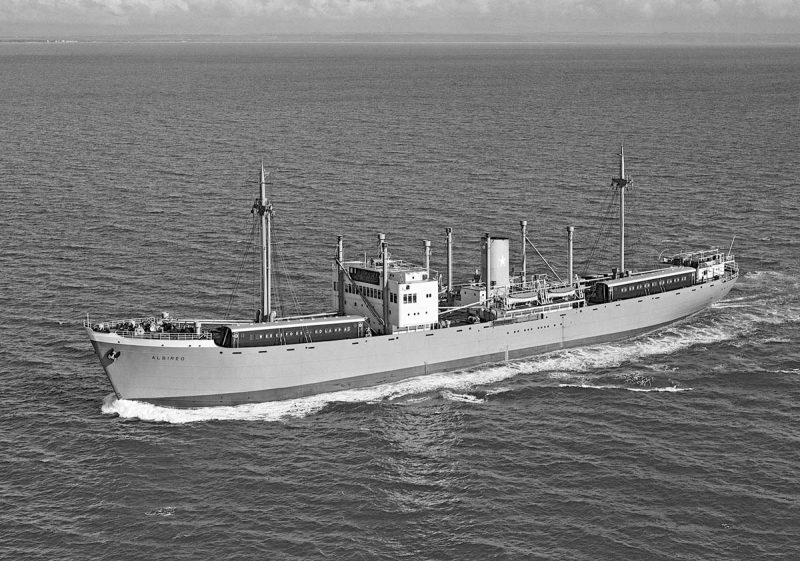
It was inevitable that fusion between RRL and Nederland Line, and the other partners in Vereenigde (VNS) would be considered. On 20th January 1970 a complete fusion of many of the big Dutch shipping companies, including RRL and Nederland Line, was announced as Nedlloyd Line. A new Board of Directors was appointed, with two each from RRL, Nederland Line, Java-China-Paket Line (JCPL), and one from VNS. A combined fleet of 84 ships included 20 ships from RRL, and of the 53 ships contributed by JCPL a further 5 were owned by RRL. However, if one included the 18 bulkers and 6 tankers of Holland Bulk Transport N.V. and the very large fleet of oil rig supply vessels of Smit Lloyd, plus the ships of two other Dutch companies, a grand total of 180 ships were owned by the new Nedlloyd Line on formation in 1970. The smart grey hulls and black funnels of Royal Rotterdam Lloyd ships with their Dutch East Indies names then disappeared into maritime history.
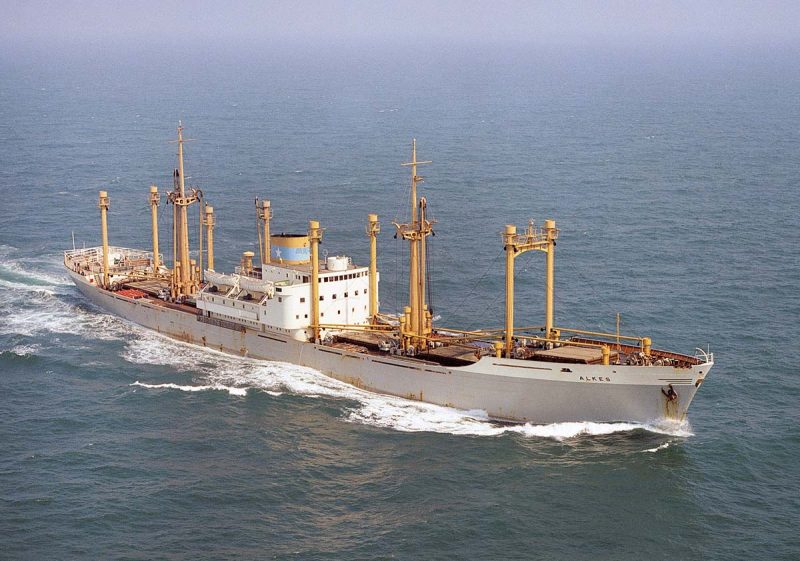
Rotterdam South America Line (Van Nievelt, Goudriaan & Company)
Passenger liners with accommodation for one hundred passengers featured in this fleet with South American and other services for ninety years. A cargo fleet was first built up from January 1905 by the Van Nievelt and Goudriaan families with names of stars and constellations e.g. Alioth, Mizar, Phecda, Megrez, Yildum, Bellatrix, Dubhe, Alkaid, Algenib and Alcor during the first ten years. War losses during the Great War were immediately replaced with newbuildings, and a passenger and cargo service was begun in 1920 to Argentina in conjunction with Holland Amerika Line.
Two steamers of 12,095 dwt were purchased on the stocks at the Vegesack yard of Bremer Vulkan from Roland Line of Bremen and renamed Aldebaran and Alderamin when completed in 1920, and were joined by eight more vessels of between 7,000 dwt and 9,000 dwt in 1921/22 in Albireo, Alchiba, Alcor, Alcyone, Algorab, Alhena, Aludra and Alwaki.
All ten vessels had accommodation for up to twelve passengers, and when Holland Amerika Line withdrew from the service in 1928, the sisters Alphacca and Alpherat were completed that year with increased accommodation for two dozen passengers.
Alcor of 1920 went on to complete forty years service with the company until scrapped at Hong Kong in 1960, but Alkaid of 1910 was unfortunately sunk in 1926 to the East of Cape Race in a heavy storm. Yellow funnels with a white five pointed star on a central light blue band made them attractive ships with grey or black hulls.
The financial crash of October 1929 led to many of the fleet being laid up during the Depression at Rotterdam, and after freight rates had picked up in 1936 Alphard of 1916 sank in fog off the Sandettie Light Vessel after a collision.
A further loss was suffered by the fleet a year later when Aldabi completed in 1921 stranded in dense fog at Cabo Santa Martha Grande near Porto Alegre in Southern Brazil and became a total loss. Four motorships were completed during 1937 from the yard of Deutsche Werft A.G. in Hamburg as Algenib, Alioth, Alkaid and Alphard and their 5 holds were served by 15 derricks and they had accommodation for a few passengers.
A large fleet of 20 cargo-liners was being traded on the outbreak of war in September 1939, and with three cargo-liner sisters also under construction at the yards of the Nederlandsche Dok Maats in Amsterdam, each with accommodation for 42 passengers.
All of the trio were taken up for service with the Third Reich and unfortunately Albireo was mined and sunk in 1942 as Wuri. A new forepart had to be built for her when she was salvaged in 1945 and she eventually entered service in April 1949 as Alnati with accommodation for 52 passengers.
Her sister Aldabi served as the German Wolta during the war, and she was able to begin the South American service to Brazil, Uruguay and Argentina in November 1945.
The third sister Algol served as Sperrbrecher 29 and was found in a heavily damaged condition at the end of the war, and after extensive repairs was able to begin her service in April 1947 as Alhena with accommodation for fifty passengers, the same number as Aldabi.
The loss of eleven ships during World War II was made good by the ordering or purchase of a equal number of new or second hand ships.
The ‘Hansa C’ war built vessel Frankenfels became Albireo of 9,611 dwt in 1946 with accommodation for fourteen passengers, and the passenger service received a boost when Alioth of 8,350 dwt from the Burntisland yard entered service in 1950 with accommodation for 92 passengers. Cabins arranged around her ‘tween decks had accommodation for 80 passengers with 12 first class passengers in the ‘midships accommodation.
Alioth was transferred to the Hamburg subsidiary of the company in 1963 and renamed Yildun, and was sold after twenty years service to Greek owners and later broken up in 1979.
Four ‘Liberty’ ships were purchased in 1947 and renamed Aludra, Alamak, Alcyone and Alderamin, and three faster ‘Victory’ types with accommodation for 12 passengers were also purchased that year and renamed Alphacca, Alpherat and Alwaki.
In 1950, the Holland-Inter America Line was set up jointly with Holland America Line to operate a service from New York to South America terminating at Buenos Aires. Branch offices were set up in post war years in Marseille, Casablanca, Sao Paulo, Rio de Janeiro, Santos, Asuncion, Montevideo and Buenos Aires to increase their share of the available cargo.
The Van der Giessen De Noord yard at Alblasserdam, the Gusto yard at Schiedam, and the Boele yard at Bolnes then completed eight cargo-liners between 1956 and 1960 as Alnitak, Aludra, Alcor, Algol, Algorab, Alkes, Alchiba and Alamak, all with accommodation for twelve passengers.
The engines aft bulkers Asterope and Asmidiske of 15,000 dwt from the Blohm & Voss yard in Hamburg were also completed at this time, with other diversifications including a large fleet of coasters for a service from Rotterdam to Bremen and Hamburg and another from Rotterdam to Portugal and Morocco.
Two crude oil tankers of 18,630 dwt named Sheraton and Sirrah had been completed in 1953 by the Nederland Dok yard at Amsterdam, with Sheraton sold after three years to Thor Dahl and Sirrah serving for a dozen years on charter to an oil major.
The Van Nievelt and Goudriaan families sold their shares in the company in 1968 to Steenkolen Handels Vereniging (SHV) and under joint Managing Directors Dr. J.A. Reus and H.C. Van Haeringen the fleet was reduced to only four cargo-liners and five coasters during the next year.
Alamak, Alchiba, Aludra and Alnitak were sold in 1969 to Wilhelm Wilhelmsen of Norway and each was then fitted with six deck cranes. In 1977, passenger carrying ended on the South American route with the sale of Algol of 1957, Algorab of 1960 and Alkes of 1958.
The trio were replaced by a new quartet of 14,700 dwt in Aldabi, Alhena, Alnati and Alphacca from the Verolme yard at Alblasserdam. They had five holds with the fifth hold aft of the engine room, and eight hatches and ‘tween decks served by four cranes and seven derricks with capacities of up to 22 tonnes, and could carry 288 TEU of containers as well as palletized refrigerated cargo.
A good speed of 15 knots from a 6-cylinder Stork Werkspoor diesel engine of 9,500 bhp enabled the quartet to reach Brazil in two weeks from Rotterdam. The quartet was laid up in 1986/87 and then bareboat chartered to D. Lemos of Greece for two years before their sale in 1988/89.
The Rotterdam South America Line had thus ended, with the only services left being coastal European services using general cargo ships of 4,200 dwt as well as feeder container ships, one of which was on charter to the huge Maersk Line as Maersk Tempo.
Three engines aft general cargo ships of 6,275 dwt were then completed in 1989/90 by the Van der Giessen de Noord yard as Aldabi, Norrsundet and Skutskar for a service between Finland and Sweden. This trio carried 255 TEU of containers in addition to general and palletized cargo in four holds, and oil could also be carried in deep tanks.
However, the company went into liquidation in 1991, and this trio were sold off in 1993 after 88 years of shipowning by the Rotterdam South America Line.





Comments
Sorry, comments are closed for this item